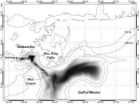(Press-News.org) DALLAS, March 19, 2014 — The health benefits of eating dark chocolate have been extolled for centuries, but the exact reason has remained a mystery –– until now. Researchers reported here today that certain bacteria in the stomach gobble the chocolate and ferment it into anti-inflammatory compounds that are good for the heart.
Their findings were unveiled at the 247th National Meeting & Exposition of the American Chemical Society (ACS), the world's largest scientific society. The meeting, attended by thousands of scientists, features more than 10,000 reports on new advances in science and other topics. It is being held at the Dallas Convention Center and area hotels through Thursday.
"We found that there are two kinds of microbes in the gut: the 'good' ones and the 'bad' ones," explained Maria Moore, an undergraduate student and one of the study's researchers.
"The good microbes, such as Bifidobacterium and lactic acid bacteria, feast on chocolate," she said. "When you eat dark chocolate, they grow and ferment it, producing compounds that are anti-inflammatory." The other bacteria in the gut are associated with inflammation and can cause gas, bloating, diarrhea and constipation. These include some Clostridia and some E. coli.
"When these compounds are absorbed by the body, they lessen the inflammation of cardiovascular tissue, reducing the long-term risk of stroke," said John Finley, Ph.D., who led the work. He said that this study is the first to look at the effects of dark chocolate on the various types of bacteria in the stomach. The researchers are with Louisiana State University.
The team tested three cocoa powders using a model digestive tract, comprised of a series of modified test tubes, to simulate normal digestion. They then subjected the non-digestible materials to anaerobic fermentation using human fecal bacteria, according to Finley.
He explained that cocoa powder, an ingredient in chocolate, contains several polyphenolic, or antioxidant, compounds such as catechin and epicatechin, and a small amount of dietary fiber. Both components are poorly digested and absorbed, but when they reach the colon, the desirable microbes take over. "In our study we found that the fiber is fermented and the large polyphenolic polymers are metabolized to smaller molecules, which are more easily absorbed. These smaller polymers exhibit anti-inflammatory activity," he said.
Finley also noted that combining the fiber in cocoa with prebiotics is likely to improve a person’s overall health and help convert polyphenolics in the stomach into anti-inflammatory compounds. “When you ingest prebiotics, the beneficial gut microbial population increases and outcompetes any undesirable microbes in the gut, like those that cause stomach problems,” he added. Prebiotics are carbohydrates found in foods like raw garlic and cooked whole wheat flour that humans can’t digest but that good bacteria like to eat. This food for your gut’s helpful inhabitants also comes in dietary supplements.
Finley said that people could experience even more health benefits when dark chocolate is combined with solid fruits like pomegranates and acai. Looking to the future, he said that the next step would be for industry to do just that.
INFORMATION:
A press conference on this topic will be held Tuesday, March 18, at 1:30 p.m. Central time in Room A122/A123 of the Dallas Convention Center. Reporters can attend in person or access live video of the event and ask questions at the ACS Ustream channel http://www.ustream.tv/channel/acslive.
This study was supported by the Louisiana State College of Agriculture and a Louisiana AgCenter Undergraduate Research Grant.
The American Chemical Society is a nonprofit organization chartered by the U.S. Congress. With more than 161,000 members, ACS is the world's largest scientific society and a global leader in providing access to chemistry-related research through its multiple databases, peer-reviewed journals and scientific conferences. Its main offices are in Washington, D.C., and Columbus, Ohio.
To automatically receive news releases from the American Chemical Society, contact newsroom@acs.org.
Note to journalists: Please report that this research was presented at a meeting of the American Chemical Society.
Follow us: Twitter | Facebook
Title
Impact of the microbiome on cocoa polyphenolic compounds
Abstract
Flavanols such as catechin, epicatechin and polymers are abundant in cocoa products, however their fate in the lower gastrointestinal tract is not clear. We investigated the impact of the human gut microbiome on three different types of cocoa powders: lavado, Geekins Sienna, and Paragon. The cocoa powders differed in sources and processing methods. The materials were predigested in a gastrointestinal model and the non-digestible residues were anaerobically fermented in a human gastrointestinal model. Short chain fatty acids, changes in pH and phenolic profiles were determined at 0, 6, 12, 18 and 24 hours. Fatty acid production was compared to hi-Maize Resistant Starch (positive control). The pH dropped slightly between 6 and 12 hours and acetic acid, butyric acid, and propionic acid were found. The phenolic profiles suggested breakdown of larger molecules to simpler phenolic acids. Colonic fermentation may be responsible for some of the benefits of coca products.
The precise reason for the health benefits of dark chocolate: Mystery solved
2014-03-18
ELSE PRESS RELEASES FROM THIS DATE:
Building heart tissue that beats
2014-03-18
DALLAS, March 18, 2014 — When a heart gets damaged, such as during a major heart attack, there's no easy fix. But scientists working on a way to repair the vital organ have now engineered tissue that closely mimics natural heart muscle that beats, not only in a lab dish but also when implanted into animals. They presented their latest results at the 247th National Meeting & Exposition of the American Chemical Society (ACS), the world's largest scientific society.
The talk was one of more than 10,000 being presented at the meeting, which continues here through Thursday.
"Repairing ...
Bees capable of learning feats with tasty prize in sight
2014-03-18
They may have tiny brains, but bumblebees are capable of some remarkable learning feats, especially when they might get a tasty reward, according to two studies by University of Guelph researchers.
PhD student Hamida Mirwan and Prof. Peter Kevan, School of Environmental Sciences, are studying bees' ability to learn by themselves and from each other.
In the first study, published in February in Animal Cognition, the researchers found bees capable of learning to solve increasingly complex problems.
The researchers presented bees with a series of artificial flowers that ...
Sauder research shows why innovation takes a nosedive
2014-03-18
A new UBC study reveals that corporate leaders are victims of herd mentality when adopting new innovations, sometimes with deadly consequences.
The paper, by Sauder School of Business Associate Professor Marc-David L. Seidel and INSEAD Professor Henrich R. Greve, shows leaders tend to pursue innovations, even as complex as airplanes, based on early adoption by competitors not close scrutiny of the technical merits.
"Business leaders tend to panic when new innovations are about to hit the market. They scramble to buy an apparent early leader," says Seidel. "Sometimes ...
Stanford researchers survey protein family that helps the brain form synapses
2014-03-18
Neuroscientists and bioengineers at Stanford are working together to solve a mystery: how does nature construct the different types of synapses that connect neurons -- the brain cells that monitor nerve impulses, control muscles and form thoughts.
In a paper published in the Proceedings of the National Academy of Sciences, Thomas C. Südhof, M.D., a professor of molecular and cellular physiology, and Stephen R. Quake, a professor of bioengineering, describe the diversity of the neurexin family of proteins.
Neurexins help to create the synapses that connect neurons. Think ...
TGen-led study spotlights dog DNA role in developing new therapies for human cancers
2014-03-18
PHOENIX, Ariz. — March 17, 2014 — Using genomic analysis to study cancer in dogs can help develop new therapies for humans with cancer, according to a proof-of-concept study led by the National Cancer Institute (NCI) and the Translational Genomics Research Institute (TGen).
Pure-breed dogs, whose genetics have been standardized by hundreds of years of human intervention, provide highly predictable genetic models useful in designing clinical trials, in which specific drugs are matched to the molecular profiles of human patients, according to the study published today in ...
Kessler Foundation researchers link body temperature to relapsing-remitting MS and fatigue
2014-03-18
West Orange, NJ. March 18, 2014. Kessler Foundation researchers have demonstrated for the first time ever that body temperature is elevated endogenously in relapsing-remitting multiple sclerosis (RRMS) and linked to worse fatigue. The article was published ahead of print on Feb. 21, 2014 in Archives of Physical Medicine & Rehabilitation. Sumowski J, Leavitt V: Body temperature is elevated and linked to fatigue in relapsing-remitting multiple sclerosis, even without heat exposure. doi:10.1016/j.apmr.2014.02.004.
Researchers measured body temperature in 50 patients with ...
NIST chips help BICEP2 telescope find direct evidence of origin of the universe
2014-03-18
The view back in time—way back to the origins of the universe—just got clearer. Much clearer.
A team of U.S. cosmologists using the BICEP2 telescope at the South Pole announced this week that they have discovered the first direct evidence of the rapid inflation of the universe at the dawn of time, thanks in part to technology developed and built by the National Institute of Standards and Technology (NIST).
The BICEP2 camera relies, in part, on the extraordinary signal amplification made possible by NIST's superconducting quantum interference devices (SQUIDs).
The ...
NRL models Deepwater Horizon oil spill
2014-03-18
Dr. Jason Jolliff is an oceanographer with the U.S. Naval Research Laboratory (NRL). "The emphasis here," he says, "is on developing models of the ocean environment to help the naval warfighter." His most recent paper, published in Ocean Modeling (March 2014), shows NRL can also forecast where oil will go following a major spill.
"If you're going to do forecasting," he says, "you have to get the ocean circulation correct. It's fundamental to all else." Jolliff plugged the distribution of surface oil following the 2010 Deepwater Horizon oil spill—when it was still well ...
Canadian drinking-age laws have significant effect on deaths among young males
2014-03-18
A recent study by a University of Northern British Columbia-based scientist associated with the UBC Faculty of Medicine and UNBC's Northern Medical Program demonstrates that Canada's drinking-age laws have a significant effect on youth mortality.
The study was published yesterday in the international journal Drug and Alcohol Dependence. In it, Dr. Russell Callaghan writes that when compared to Canadian males slightly younger than the minimum legal drinking age, young men who are just older than the drinking age have significant and abrupt increases in mortality, especially ...
Global food trade can alleviate water scarcity
2014-03-18
Trading food involves the trade of virtually embedded water used for production, and the amount of that water depends heavily on the climatic conditions in the production region: It takes, for instance, 2.700 liters of water to produce 1 kilo of cereals in Morocco, while the same kilo produced in Germany uses up only 520 liters. Analyzing the impact of trade on local water scarcity, our scientists found that it is not the amount of water used that counts most, but the origin of the water. While parts of India or the Middle East alleviate their water scarcity through importing ...





